 Nick Wright is a trained facilitator, accredited mediator and chartered urban planner. He worked as a local authority planner for 15 years before setting up Nick Wright Planning in 2004. He has been involved in pilot Local Place Plans in Paisley, Kirkwall and Stromness, and community-led plans throughout Scotland. He recently drafted How to Guides for Local Place Plans for the Scottish Government and Renfrewshire Council, and carried out Scottish Government action research on Local Place Planning in 2019-20.
Nick Wright is a trained facilitator, accredited mediator and chartered urban planner. He worked as a local authority planner for 15 years before setting up Nick Wright Planning in 2004. He has been involved in pilot Local Place Plans in Paisley, Kirkwall and Stromness, and community-led plans throughout Scotland. He recently drafted How to Guides for Local Place Plans for the Scottish Government and Renfrewshire Council, and carried out Scottish Government action research on Local Place Planning in 2019-20.
In this article, he explores how Local Place Plans and Town Centre Plans can help create 20 minute neighbourhoods across Scotland.
The green recovery, creating places for people, supporting communities to shape where they live: turning these lofty Scottish Government aspirations into reality is what I think planning is all about. It’s an exciting challenge. And now we’ve got two new important tools to help us: “20-minute neighbourhoods” and Local Place Plans.
20 minute neighbourhoods
20 minute neighbourhoods were given a stamp of authority in the Scottish Government’s 2020-21 Programme for Government, and received cross-party support in most major parties’ manifestos for this year’s Holyrood elections. I’m sure I’m not alone in hoping that this will be backed up by funding not just to plan but, equally importantly, deliver 20 minute neighbourhoods across Scotland.
20 minute neighbourhoods won’t happen overnight. My job as a planner, using mechanisms like Local Place Plans and town centre plans, is to work with communities, infrastructure providers, the NHS and other public services to plan this ‘walkable’ future pattern of shops, services, work, education, infrastructure etc, from quick wins to long term investment. As a profession we’ve been trying for years, but we need to do better. I hope 20 minute neighbourhoods and Local Place Plans will help.
Local Place Plans
The other new tool that’s around is Local Place Plans – or it will be, once the current Scottish Government consultation is complete (deadline 25 June), and secondary legislation and guidance has been developed and published.
I see Local Place Plans and 20 minute neighbourhoods as two sides of a coin: 20 minute neighbourhoods describe what we’re aiming for and give it national priority; whilst the signs are that Local Place Plans will enable that objective to be tailored and delivered at the local level.
Local Place Plans have immense potential to be the collaborative focus for government and communities to “meet in the middle”:
- Government setting national priorities.
- Communities setting local aspirations.
- Everyone collaborating to deliver the goods.
Collaborating to deliver
Today’s reality is that making towns the best they can be is neither top-down nor bottom-up, but about this “meeting in the middle”. Communities (both the business and third sectors) can tap into funding that local authorities cannot access, they have local knowledge, and they have, or can, develop capacity (with the right support) to make things happen. Local authorities deliver public services, wield regulatory power and have skills and knowledge that can help to turn community aspirations into reality.
We all know that there is widespread mistrust between government and communities, that’s nothing new. Just look at all the media coverage of the challenges around creating “liveable neighbourhoods” that erupted during the pandemic. Local Place Plans are the perfect mechanism to marry up local and national agendas, as well as deliver the Scottish Government’s much vaunted community empowerment agenda in every community.
Working collaboratively to deliver 20 minute neighbourhoods isn’t pie in the sky. This notion of collaborative action spanning communities and the public sector is perfectly practical. I’ve seen it work with my own eyes in lots of places. Here are two salient examples – neither are perfect, but each has learning points.
Paisley
In Foxbar, a neighbourhood of around 8,000 folk in Paisley, a pilot Local Place Plan was prepared by the local community and the local authority a couple of years ago. Through lots of community engagement, a really simple plan emerged with just nine projects that responded to local priorities (more information about the process and the plan here).
Some of the projects were long-term public-sector initiatives, like new housing on vacant Council sites; others were community-led quick wins, like reinstating the annual gala day and acquiring land for community gardening. Both of those quick wins happened, and the longer-term ambitions are being taken forward.
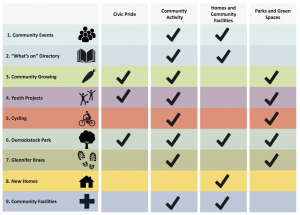
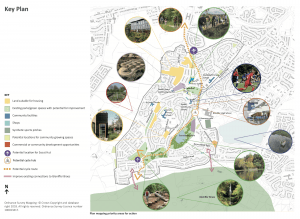
Would this plan make Foxbar into a 20 minute neighbourhood? Probably, yes. Although that wasn’t the objective, all of the components of 20 minute neighbourhoods that need action are covered in the plan.
Nairn Links
Nairn is a second example – or rather, one specific part of Nairn, the Links. This much-loved part of the town, adjacent to the town centre, is popular with locals and visitors as the town’s main greenspace, beach, promenade and visitor area. But, a couple of years ago, with lots of competing uses happening in a relatively small space, investment needed and public tensions between different players, it was clear that a collaborative plan was needed – as a way of getting through the conflict to consensus.
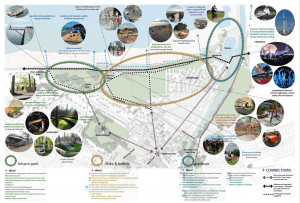
The point is that it consciously brought together the key players across the local community: residents, community groups, businesses and the local authority. Leading to a series of projects which everyone could get behind and deliver.
The most pressing tension, and therefore the highest profile project in the plan, was the need to replace the ageing and unsafe paddling pool. Historically the focus of activity at the Links in the busy summer season, the pool had been closed due to safety concerns and had become a very prominent bone of contention.
What the plan did was ease tensions by helping the key players to come together around a shared vision and initial action for the paddling pool. This meant that they could get beyond the impasse and conflict that was stymying progress. The year after the plan was finished the paddling pool was replaced with a contemporary new splashpad.
Situations like Nairn are common across Scotland and the UK: they are caused by human nature. That’s why we need to use collaborative tools like Local Place Plans to make progress.
Challenges to collaboration
I could mention other examples of collaborative planning delivering the goods – for instance, levering in resources for staff capacity and community land purchase in Langholm, building locally controlled community-led housing in Fort Augustus, and acquiring vacant town centre properties for re-use in Huntly town centre – and many, many more besides.
Although there are lots of examples of collaborative planning leading to delivery, that doesn’t mean it’s easy.
There are huge challenges to working collaboratively to deliver the lofty aspirations of 20 minute neighbourhoods. Here are two that I’m particularly conscious of from my own experience:
- Real collaboration is difficult to achieve – it’s a big change for communities to move from arguing with local authorities to working with them, and it’s a big change for local authorities to move from their traditional ‘authority’ role to one of partnership and support. The challenge of collaboration is to combine the different agendas, timescales and ambitions of residents, businesses and government.
- How should resources be targeted? There isn’t enough money or professional support amongst local authorities to prepare Local Place Plans everywhere in Scotland, let alone deliver the 20 minute neighbourhoods that they propose. So how do we ensure that the resources for plan preparation and delivery go to the places that need them most, not necessarily those which shout the loudest
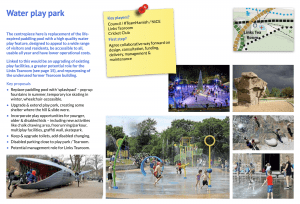
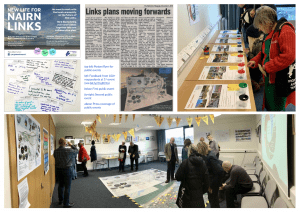
If you are interested in joining SURF’s 20 Minute Neighbourhood Practice Network you will find more details here.
